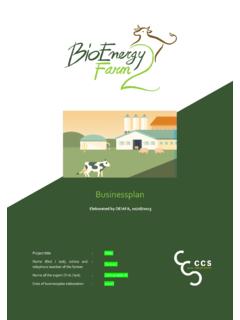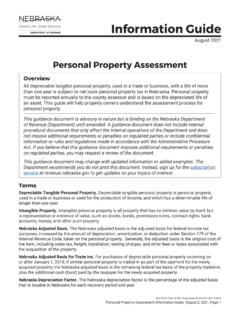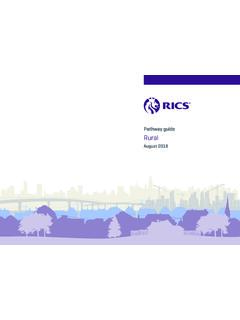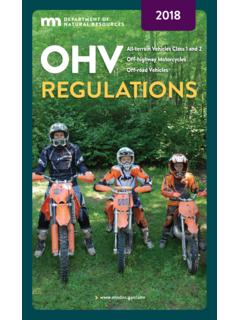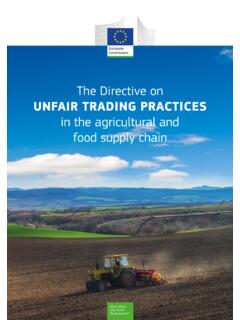Transcription of Implementation Guide For Small-Scale Biogas Plants
1 Author(s) : Mark Paterson et al. Company : KTBL Deliverable : Report no. : BEF2-15003-EN Version : Status : Public Translator(s) : Mark Paterson Date : 21/05/2015 Implementation Guide For Small-Scale Biogas Plants A farmers handbook Manure, 2 | 2 | Imprint This publication was created within the EU-Project BioEnergy Farm II - Manure, the sustainable fuel for the farm . The project is co-funded by the Intelligent Energy Europe Programme of the European Union. contract N : IEE/13/683 Author(s) : Mark Paterson et al. Company : KTBL Addres : Bartningstra e 49 | 64289 Darmstadt | Germany Deliverable : Report no. : BEF2-15001-EN Version : Status : Public Translator(s) : Mark Paterson Date : 21/05/2015 With contributions from: Katrin Kayser, IBBK, Germany Stephanie Bonhomme, TRAME, France Edward Majewsk, FNEA, Poland Marek Amrozy, NAPE, Poland Remigio Berruto, DEIAFA, Italy Franco Parola, COLDRETTI, Italy Jan Willem Bijnagte, CCS, The Netherlands Mark Paterson, KTBL, Germany Marleen Gysen, Innovatiesteunpunt, BelgiumPlease use the following reference: Mark Paterson et al.
2 , Implementation Guide For Small-Scale Biogas Plants , BioEnergy Farm II Publication, KTBL, Germany, 2015 Acknowledgements This handbook is based on the Implementation Guide Implementing a bioenergy plant (D ) from the EU-Project BioEnergy Farm , written by B. Castillo of University of Stuttgart and contains contributions and results obtained by the partners of the BioEnergy Farm II-Project. All the people involved in this project have our warmest gratitude for their contribution to the overall project work and activities and for their contribution to this handbook. The English version of this report was translated into Danish, Dutch, French, German, Italian and Polish. For each language edition, chapter Annex 3 was adapted. Layout: BBPROJ & CCS Cover picture: BBPROJ All rights reserved. No part of this publication may be reproduced in any form or by any means, in order to be used for commercial purposes, without permission in writing from the publisher.
3 The sole responsibility for the content of the Implementation Guide lies with the authors. It does not necessarily reflect the opinion of the European Union. The European Commission is not responsible for any use that may be made of the information contained therein. This Implementation Guide is meant to give assistance in the realization of a small scale Biogas project. The BioEnergy Farm II consortium and the editor do not guarantee the correctness and/or the completeness of the information and the data included or described in this publication. the sustainable fuel from the farm | 3 CONTENT Introduction 6 The BioEnergy Farm II-Project 6 Aim and content of the Implementation Guide 8 1. Biogas an introduction 10 Basics of Biogas formation 10 Biogas production 11 Biogas utilization 12 Digestate treatment 13 2.
4 General information for realizing a Biogas project 15 3. Project idea 17 Feedstock availability 18 Plant size and capacity 18 Energy output and residues 19 Expected investment & benefits 20 Type of company for Biogas businesses 20 Inspect existing Plants (field reports) 21 4. Feasibility assessment 22 Substrate potential 23 Biogas technology 24 Suitable location 25 Energy output and use 25 Economy 26 Type of company & role of the farmer 27 Project bottlenecks 27 Manure, 4 | 4 | 5. Project concept and business plan 28 SWOT-Analysis 28 Business plan 30 6. Project realization 31 Permits 31 Project financing and funding 33 Improving acceptance 33 Contracts 34 Tendering procedure 35 Building the plant and start of operation 35 7. Plant operation 36 Start of operation 36 During operation 37 Safety of Biogas Plants 40 General information on contracts 41 Plant construction contract 41 Management and maintenance contract 41 Substrate delivery and digestate collection contracts 42 Heat supply contract 42 Biogas supply contract 43 Concession agreement with land owners 44 Path easement agreement with the community 44 Checklists 45 Checklist for developing a project idea 45 Checklist for approval documents 48 the sustainable fuel from the farm | 5 Country specific data and information 50 Types of legal forms of companies 50 Proceeding of permits 69 Emission regulations 86 Subsidy regulations 94 Further information (publications)
5 124 Contacts for information and consulting 127 References 133 The literature and sources used in the handbook (general chapters). 133 The literature and sources used for the county specific information in the handbook. 134 Annex 5. Project partners 140 Manure, 6 | 6 | Introduction To conserve finite fossil fuels and to simultaneously reduce greenhouse gas emissions and mitigation of global warming a gradual switch within renewable energy sources is a necessary task in the next decades. Here bioenergy plays a central role - also for agriculture branch. Bioenergy is a largely CO2-neutral energy source and it is permanently renewable, as it is produced out of biomass, which is actually a living storage of solar energy through photosynthesis. The production and utilisation of Biogas has a special role within the renewable energies, because it is suitable for the simultaneous production of electricity and heat, useable as fuel for transport and as a substitute for natural gas.
6 In addition, it can be used flexibly and relatively simply stored. And the Biogas production is not subject to seasonal, diurnal or weather-related fluctuations and can also be generated from agricultural residues and leftovers. The production and utilization of Biogas provides environmental and socioeconomic benefits for the society as a whole as well as for the involved farmers. Utilization of the internal value chain of Biogas production enhances local economic capabilities, safeguards jobs in rural areas and increases regional purchasing power. It improves living standards and contributes to economic and social development [SEADI ET AL 2008]. Also the worship of environmental soundness and sustainability in the agriculture, especially in livestock farming, is becoming more and more important. The carbon footprint of meat, milk and related products is high compared to vegetable food.
7 One of the main reasons is the emission of methane by cold digestion of the manure produced by the animals. A good solution to reduce the emission of methane is to produce Biogas out of the manure in Biogas installations. Therefore more and more farmers are interested in connecting manure utilisation and climate protection intelligently by using Biogas technology. In most European countries the Biogas sector started by digesting manure in combination with coproducts like maize, wheat, grass, etc. which can also be used as feed for animals. The food vs. feed discussion is an important issue, so the Implementation of co-digestion is decreasing sharply in Germany, Belgium and the Netherlands. The EU-Project BioEnergy Farm II - Manure, the sustainable fuel for the farm aims to provide practical guidance to farmers to produce Biogas on farm based scale in small Biogas Plants and at the same time contributing to farm income and delivering environmental friendly energy.
8 The handbook was created to support farmers interested in implementing a small scale Biogas plant on their farm. The BioEnergy Farm II-Project The motivation behind the EU-Project BioEnergy Farm II - Manure, the sustainable fuel for the farm is, to promote on-farm production of renewable energy from Small-Scale anaerobic digestion, which mainly uses manure and agricultural residues of the farm. The project will help to improve the public opinion about agricultural Biogas production and will contribute to make livestock farming more sustainable by producing on-farm energy for self-sufficiency or feed-in, reducing emissions, improving manure as farm-fertilizer (closing nutrient cycle) and generating agricultural added value. The project is based on the observation that, despite its multiple benefits, small scale Biogas Plants are not yet widely implemented in European livestock farming, or its Implementation varies extremely between the European member states.
9 The aspects the BioEnergy Farm II project treats are manifold; it will inform farmers, policy makers and other interested parties about existing concepts for micro-scale Biogas Plants with a market overview incl. an estimation of market potential of micro scale Biogas Plants in Europe. In addition to the creation of this manual for the development and execution of a Biogas project, the project will furthermore assist farmers by checking the feasibility of a micro-scale digester for their own farm. Within these feasibility studies, different ways of Biogas utilization can be analysed, like the sustainable fuel from the farm | 7 producing electricity and heat with a CHP installation, gas upgrading to be fed into gas grids, producing heat in a Biogas boiler or for Biogas upgrading to generate natural gas substitute to be used for transport fuel.
10 To improve the profitability of micro-scale installations, the treatment of the digestate to improved fertilizers quality will be taken into account as well. Manure processing will further increase the sustainability of livestock farming, besides the environmental benefits of the production of Biogas and the reduction of greenhouse gas emissions from manure storage. The project will also outline Implementation barriers regarding legal and financial framework and identifies improvement options for the development of manure based Biogas production by on-farm micro-scale digester to farmers and policy makers, too. The major outcomes and deliveries produced and published as part of the project, in order to support implantation of Small-Scale anaerobic digestion are: Market overview of micro-scale Biogas Plants in European countries The report presents a European market overview on Small-Scale anaerobic digestion, presents best practice examples and an estimation of market potential in Europe.

